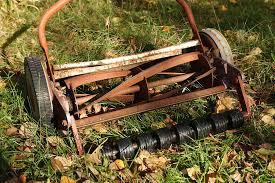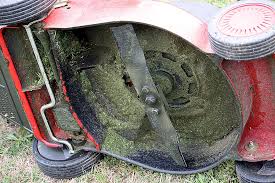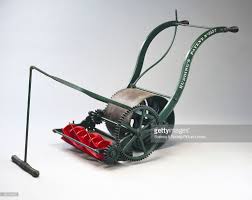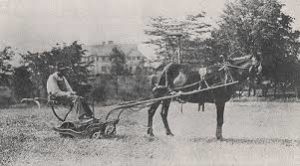If you have a petrol mower, then you will have already experienced the multiple benefits that come with using one. Not only are they far more powerful, but they also get the job done in a much shorter amount of time. However, because they run on an engine, there is also more of a chance that you might experience problems with them. One of the most common problems that people report is the lawn...
Linggo, Abril 14, 2019
Do Robotic Lawn Mowers Actually Work? Find Out Here!
We have now reached a day and age where technology has progressed so much that virtually everything is controlled digitally and garden tools are no exception. There are many types of lawn mowers available these days and one of the most intriguing is the robotic lawn mower. What a lot of people may find themselves wondering is whether or not they actually work. In fact, they work very well and...
What Is A Self Propelled Lawn Mower – The Ultimate Guide
There are so many different types of lawn mowers available these days, but one that is gaining a lot more popularity is the self propelled lawn mower. These types of lawn mower typically work by the user pressing a bar which controls the mower. All you have to do is guide the mower around the garden. As you can imagine, there are a lot of benefits that come with this type of lawn mower.
Petrol Lawn Mower Won’t Start – Find Out Why Here!
Petrol lawn mowers are fantastic machines; they have a lot of benefits. You don’t have to worry about power cords getting in your way, they are far more powerful and they get the job done in much less time. More and more people are making the switch from electric to petrol mowers. However, like all machines, there are going to be times where you will encounter problems. Read on below to find...
Huwebes, Abril 11, 2019
Mowing Wet Grass – Is It A Good Or A Bad Idea?
The summer months are fast approaching and everyone is rushing to get their gardens looking beautiful. One of the jobs that needs to be kept on top on in order to do this is the mowing of the lawn. However, as we all know, British weather is often very unpredictable. When the grass is wet because of rainfall, you might find yourself wondering whether or not you can mow the wet grass.
Linggo, Mayo 27, 2018
How To Sharpen Lawn Mower Blades – Your Ultimate Guide
Lawn mowers are undeniably a hugely important tool for the gardener. Whether you’re a casual spot of gardening type person, or a full blown green fingered fanatic, the lawn mower is a pretty essential part of the gardening routine!
Keeping your lawn mower blades sharp is so important! Often people don’t even look at how blunt their blades are, but you really run the risk of yanking your lawn instead of a nice clean slice, which is not only nicer but healthier for your lawn as well. A sharp blade keeps your mower running in tip top condition and will mean less effort for you in the long run. I’m going to give you a few of my favourite tips on keeping your blade extra sharp, and all from the comfort of your own garden.
A lot of people probably are wondering whether you can safely sharpen the blade on your own lawnmower. The answer is “YES!” And you’re probably now wondering how to do it? Well keep on reading and you will find out how.
Firstly you must make sure the mower is not attached to the mains! It might sound obvious, but better safe than sorry!
So, very simply, remove the blade by unscrewing the nut that attaches it to the motor. Remove any ruse with a steel brush or steel wool. This is easy to acquire at any hardware or gardening store. Give it a good old brush with some elbow grease, till the orangey colour has gone.
Then you’re going to need to get hold of a clamp or a vice. Most DIYers will have one of these in a shed, but if not, don’t be afraid to pop over and ask a friendly neighbour! Clamp the blade in a vice, or to the edge of a solid work surface. Now were going to file the blade. Run the file along the cutting edge, thats the narrower sharper edge, trying to follow the same angle on the blade.
 In some cases the blade can be badly damaged. This could be from long-term use, or from trying to cut through tougher things than your mower can handle, or from kicking up rocks or wood getting jammed. If it is badly damaged you may need to use a bench-grinder or have it professionally sharpened, which shouldn’t be too expensive if you shop around. (again just pop down to your local hardware store and ask around there)
In some cases the blade can be badly damaged. This could be from long-term use, or from trying to cut through tougher things than your mower can handle, or from kicking up rocks or wood getting jammed. If it is badly damaged you may need to use a bench-grinder or have it professionally sharpened, which shouldn’t be too expensive if you shop around. (again just pop down to your local hardware store and ask around there)
If you do use a power grinder sharpen your blade, make sure the blade doesn’t over heat. This can weaken the blade, so be sure to dip the blade in water frequently during the sharpening process.
To remove any nicks or grooves you need to run the blade along the grinding wheel. Then hold the blade at the proper angle (the angle already on the blade) and grind the length of the blade until its sharp.
Remember, you want your blade to be about as sharp as a butter knife, it shouldn’t be as sharp as a razor blade. Not only do you risk cutting yourself, but the blade will curl in places where it hits little pebbles or wood. There is no need for it to be this sharp as the speed and angle will cut the grass perfectly at this sharpness.
There is a “lazy” way of sharpening your blade which would be to use coarse grit sandpaper. If you don’t have large nicks in your blades this will do the trick as a quick fix, and will clean up the edge nicely.
To check that the blade is balanced you simply need to balance the blade from the counterpoint on a Blade Balancer, a very inexpensive tool, or a nail. If the blade isn’t balanced, you can remove some of the material from the heavier side, but make sure not to remove it from the cutting edge.
 Now that your blade is all nice a sharp, you can re-attach it to your lawn mower with the nut.
Now that your blade is all nice a sharp, you can re-attach it to your lawn mower with the nut.
The more you sharpen your blade, the quicker and easier the task will be. If you frequently use your mower, I would recommend sharpening your blade every couple of months, but you can be the best judge of that. If you notice that your mower isn’t cutting as finely, maybe its time for a sharpening!
A few points to remember! –
- Butter knife, not razor blade
- Don’t change the over-all angle of the blade! (the manufacturer probably knows best!)
- Make sure you’re balanced, this can harm the mower permanently
- Curved mulching blades might be harder to sharpen, you could think about simply replacing it
- Replacement blades can be found quickly and easily, don’t be afraid to just replace it!
So, now that you know how to sharpen your lawn mower blades, you can easily do it yourself! No more chopping and hacking at that lawn with a blunt blade, the 15 minutes it took for you to do that has surely taken a lot of the stress and sweat out of your lawn mowing!
Read more about How To Sharpen Lawn Mower Blades – Your Ultimate Guide on The Best Mowers UK.
Who Invented The Lawn Mower & History Of Mowers
Mower History 101
Lawn mowers. Every proud gardener needs one, and if you don’t have one, your neighbour probably will! Theres no better feeling than looking out at a freshly cut lawn on a sunny day. The vibrant colour brightening up anyone’s garden, and the fresh smell tickling your senses. Its undeniable that the lawn mower is the modern gardeners essential.
Let’s take a look at where the lawn mower came from… Who was the first one to come up with it? And why?
 The first ever lawn mower was invented by a man called Edwin Budding in 1830. In a town called Thrupp, in Gloucestershire. They were initially invented to cut the grass on sports grounds and stately gardens. Up until then they used a scythe, but the lawn mower was granted a British patent on August 31st, 1830.
The first ever lawn mower was invented by a man called Edwin Budding in 1830. In a town called Thrupp, in Gloucestershire. They were initially invented to cut the grass on sports grounds and stately gardens. Up until then they used a scythe, but the lawn mower was granted a British patent on August 31st, 1830.
The first ever mower, which was pushed from behind, was made from wrought iron. It measured at 19 inches or 480mm.
The similarity between this mower and the modern models are astonishingly similar. Cast-iron gear wheels transmitted power from the rear roller to the cutting cylinder. Another roller placed between the cutting cylinder and the main roller could be raised or lowered depending on how long or short you wanted your grass to be cut. So they pretty much worked in the same way the mowers we use now. You know what they say, If it ain’t broke, don’t fix it!
The first machines, made by Budding, were sold to Regent’s Park Zoological Gardens in London and the Oxford Colleges. John Ferabee and Edward Budding had made an agreement that Ferabee would pay the costs to enlarge the small blades. They obtained patenting letter and got the rights to manufacture, sell and license the manufacturing of lawn mowers.
Soon after, other companies began making copies of their mower under license, and in 1832 the most successful copy was a mower made by Ransomes of Ipswich.
Ten years later and the traditional lawn mower has been improved and modified to be pulled by animals. A nice improvement to make lawn mowing nice and easy for the ever-evolving man.
It wasn’t until sixty years later that a steam powered lawn mower was built. Thomas Green and Son of Leeds introduced a new model called the Silens Messor (meaning silent cutter). These machines were lighter and quieter than their predecessor and soon replaced the scythe and domesticated grazing animals. With a growing popularity in lawn sports the invention started to spread and its demand grew.
 The history of the lawn mower is extensive, and I could really go on for days! But you can imagine how the advances in technology has brought us to where we are today, with super snazzy gadgets such as the ride-on mower, hover mowers, and even robotic mowers.
The history of the lawn mower is extensive, and I could really go on for days! But you can imagine how the advances in technology has brought us to where we are today, with super snazzy gadgets such as the ride-on mower, hover mowers, and even robotic mowers.
Probably the most advanced in the lawn mower technology is the robotic mower. It is contained by a border, which the robotic mower uses to locate the boundary of the desired mowing area. It often is able to locate its own charging dock and is self-docking. It can maintain an area of up to 5 acres of grass, and can contain a rain sensor, which almost entirely eliminates human interaction for mowing grass. Will the robots really be running us all out of jobs and taking over the planet?
Although lawn mowers are arguably an absolute necessary invention, they haven’t come without their issues! In the United States alone, over 12,000 people per year are hospitalised as a result of lawn mower related injuries! Rotary mowers can shoot out debris with extreme speed and power! As well as the blades of powerful push motor being strong and sharp enough to cause serious injury. It is always recommended to wear protective footwear and eyewear, as most injuries can be prevented.
 Lawn mowers are also responsible for a fair amount of environmental damage, as many things are with the advance of technology and the amount of power we need. A study has shown that some mowers are capable of producing the same amount of pollution in one hour, as driving a vehicle for 650km! Another report claims that the amount of pollution from a lawn mower can be up to four times the amount from a car per hour. Thats pretty bad… but luckily most of us only need to mow the lawn a minimum of once a week, and we’re not using our ride on lawn mowers to get to work every day!
Lawn mowers are also responsible for a fair amount of environmental damage, as many things are with the advance of technology and the amount of power we need. A study has shown that some mowers are capable of producing the same amount of pollution in one hour, as driving a vehicle for 650km! Another report claims that the amount of pollution from a lawn mower can be up to four times the amount from a car per hour. Thats pretty bad… but luckily most of us only need to mow the lawn a minimum of once a week, and we’re not using our ride on lawn mowers to get to work every day!
I couldn’t live without my lawn mower, with mulching blades, so that the clippings circulate until they are chopped up into tiny little pieces, and fall into the ground, to conveniently create compost and fertiliser. It also means I don’t have to rake and collect the clippings, which is definitely the worst part of gardening! It just might not be so great for my friends who suffer from hay fever! Sorry!
So, the man we have to thank for our freshly cut lawns is the great Edwin Budding. Without his ingenious invention to cut lawns into lovely uniform blades of grass, we would all be sat relaxing in our over grown gardens, probably listening to the sweet sound of a couple of bleating goats, which, as blissful as it sounds, i’m just not sure its something I could compare to my gorgeously lush, uniform lawn. So, hats off to Mr Budding!
Read more about Who Invented The Lawn Mower & History Of Mowers on The Best Mowers UK.